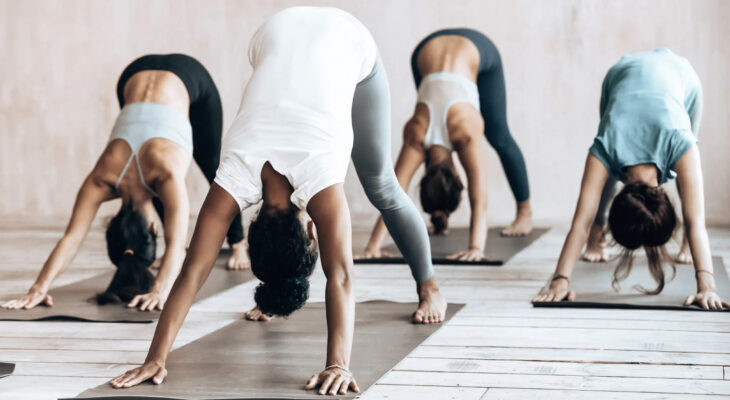Yoga is an age old practice comprised of physical and mental exercises that offer a plethora of physical and mental health benefits. From increasing flexibility, strength and muscle tone to promoting physical and mental well being and stress reduction, yoga has become increasingly popular in Western cultures as an alternative means of achieving optimal physical and mental health.
There are many different types of yoga poses, each targeting different areas of the body and mind. While some poses may be more suitable for physical benefits, others can be used to stimulate mental health and emotional wellbeing. Here we will explore 10 of the best yoga poses for mental health, the benefits of each, and how to practice them.
- Child’s Pose (Balasana)
Child’s Pose is a gentle, restorative pose that is used to promote emotional and mental balance. By relaxing the back, chest and shoulders, it can help to relieve tension and stress. Physically, this pose helps to stretch the hips, thighs, and ankles, as well as strengthen the back muscles. To do this pose, start by kneeling on the floor, bringing the big toes together and knees about two feet apart. Then, exhale and lower the torso and forehead onto the mat, arms stretched ahead or to the sides. Taking slow, deep breaths in this pose can help to relax the mind while focusing on the physical sensations of the pose can aid in the release of built-up emotions.
- Corpse Pose (Savasana)
Corpse Pose is a popular pose used to achieve full body relaxation and promote mental clarity. To begin this pose, start by lying flat on your back with your arms and legs spread, palms up. Then, focus your breath into each part of your body and let go of any physical tensions or worries. Spending just a few minutes per day in Savasana can be extremely beneficial for mental health and clarity.
- Cat-Cow (Marjaryasana-Bitilasana)
Cat-cow pose is an effective way to release tension and stress. The combination of multiple postures allows for a calming release of the spine and chest and can also improve digestion and alignment. To do this pose, start in a tabletop position with hands and knees on the ground. As you inhale, arch the spine toward the ceiling and gaze up, and as you exhale, round the spine and gaze down. Repeat this while focusing on the breath and allowing each inhalation and exhalation to flow easily.
- Seated Forward Fold (Paschimottanasana)
The Seated Forward Fold is a great way to calm the mind and restore the body. It encourages introspection, deep breathing and letting go of stress, while also helping to stretch the spine, neck, and back. To do this pose, sit cross-legged with your spine erect and inhale, then gradually exhale and fold forward, allowing the forehead and chin to touch the ground. Let your arms rest alongside the legs and allow the head to relax. When the pose is done, slowly roll up to the sitting position and notice any improvements in your mental and emotional state.
- Extended Triangle (Utthita Trikonasana)
The Extended Triangle is a very balanced pose that works to increase flexibility, strength, and balance. On a mental level, this pose can help to focus on the present moment, and outwardly direct the energy to heal and empower. To do this pose, stand with feet about three to four feet apart, and bring the arms parallel to the ground. Then, spread the thighs and reach the right arm over the left leg and grab the outside of the left foot. Inhale to extend the right arm towards the ceiling before exhaling and bringing the right arm and body down. After holding the pose, switch to the other side and repeat.
- Warrior I (Virabhadrasana I)
Warrior I is a powerful pose that promotes inner strength and stability. It helps to open the chest and hips, as well as build strength in the legs and arms. On a mental level, it helps to center your thoughts and clear the mind while building confidence in your own power and capabilities. To do this pose, stand with feet about four feet apart and turn your left foot out 90 degrees and your right foot in a 45-degree angle. Then, bend your left knee to 90 degrees, making sure your knee is directly above your ankle, and raise the arms up high. Hold the pose for 30 seconds or longer and release with an exhalation.
- Child’s Pose Twist (Marichyasana)
The Child’s Pose Twist is an excellent yoga pose for improving self-awareness and stimulating mental focus. It helps to stretch and open the spine and muscles of the back, while aiding in digestion and detoxification. To do this pose, start in Child’s Pose and bring the left arm out to the side and over the head, letting the left fingertips reach out to the right side. Gently twist the torso and turn the head in the opposite direction, staying here for 30 seconds before repeating on the other side.
- Bridge Pose (Setu Bandha Sarvangasana)
The Bridge pose is a great pose for improving spinal flexibility and restoring energy levels. On the mental level, it naturally calms the mind and helps promote relaxation. To do this pose, lie on your back, feet flat on the ground, and slowly lift the pelvic area and torso off the floor. Clasp your hands together and hold the pose while focusing on your breath and making each inhalation and exhalation deeper and calmer.
- Reclined Hero Pose (Supta Virasana)
The Reclined Hero Pose is a resting pose that helps to relax the body and mind. This yoga posture can help to open the chest, improve digestion, and relieve stress. To do this pose, kneel and sit on your putty. Then, gently lean back onto the elbows, allowing the head and the torso to relax onto the floor. Here, focus on the breath and bring your awareness to the present moment, letting go of all mental and physical stress.
- Corpse Pose (Shavasana)
Corpse Pose is a basic yoga pose used for relaxation and meditation. It helps to release bodily tension and allows the digestive system to function properly. To do this pose, start by lying flat on your back and releasing any physical tensions or worries. Take a few deep, slow breaths and let your body and thoughts rest here for a few minutes.
Yoga can be a highly therapeutic practice, providing not only physical benefits but also mental and emotional. Incorporating 10 simple yoga poses into your routine can be a gentle, yet effective way to boost your mental health and emotional wellbeing. Be sure to practice these poses with caution, going only as far as comfortable in each pose, and never pushing too hard. With commitment and dedication, you may find that these yoga poses bring a new level of peace and clarity to your life.





